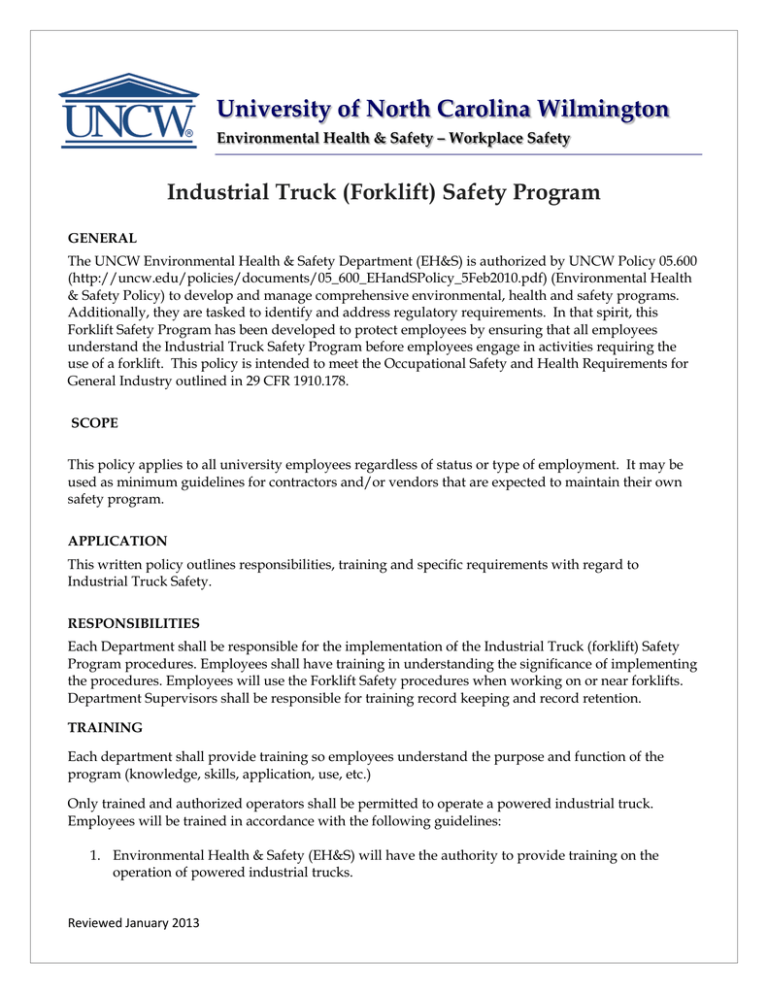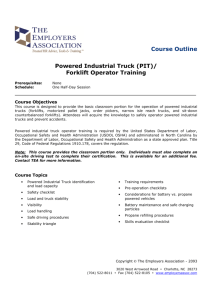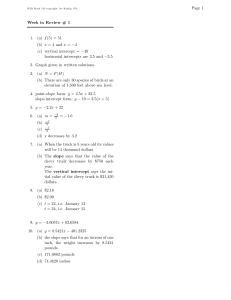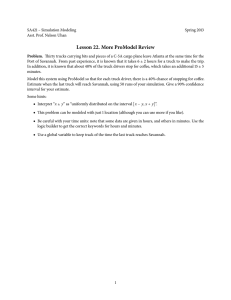University of North Carolina Wilmington Industrial Truck (Forklift) Safety Program
advertisement

University of North Carolina Wilmington Environmental Health & Safety – Workplace Safety Industrial Truck (Forklift) Safety Program GENERAL The UNCW Environmental Health & Safety Department (EH&S) is authorized by UNCW Policy 05.600 (http://uncw.edu/policies/documents/05_600_EHandSPolicy_5Feb2010.pdf) (Environmental Health & Safety Policy) to develop and manage comprehensive environmental, health and safety programs. Additionally, they are tasked to identify and address regulatory requirements. In that spirit, this Forklift Safety Program has been developed to protect employees by ensuring that all employees understand the Industrial Truck Safety Program before employees engage in activities requiring the use of a forklift. This policy is intended to meet the Occupational Safety and Health Requirements for General Industry outlined in 29 CFR 1910.178. SCOPE This policy applies to all university employees regardless of status or type of employment. It may be used as minimum guidelines for contractors and/or vendors that are expected to maintain their own safety program. APPLICATION This written policy outlines responsibilities, training and specific requirements with regard to Industrial Truck Safety. RESPONSIBILITIES Each Department shall be responsible for the implementation of the Industrial Truck (forklift) Safety Program procedures. Employees shall have training in understanding the significance of implementing the procedures. Employees will use the Forklift Safety procedures when working on or near forklifts. Department Supervisors shall be responsible for training record keeping and record retention. TRAINING Each department shall provide training so employees understand the purpose and function of the program (knowledge, skills, application, use, etc.) Only trained and authorized operators shall be permitted to operate a powered industrial truck. Employees will be trained in accordance with the following guidelines: 1. Environmental Health & Safety (EH&S) will have the authority to provide training on the operation of powered industrial trucks. Reviewed January 2013 2. No one shall operate a powered industrial truck/ forklift unless they have received training in accordance with this standard practice instruction. 3. Any employee who refuses such training will not be permitted to operate a forklift. Retraining: Retraining shall reestablish proficiency and introduce new or revised control methods 1. There shall be retraining with any change in job assignments, change in machines, equipment or process that presents a new hazard or a change in procedures 2. Retrain when inspection reveals a need or whenever the employer sees a need 3. Retraining shall be completed every three (3) years SPECIFIC REQUIREMENTS Operations Program 1. Trucks shall not be driven up to anyone standing in front of a fixed object. 2. No person shall be allowed to stand or pass under the elevated portion of any truck, whether loaded or empty. 3. Unauthorized personnel shall not be permitted to ride on powered industrial trucks. Arms or legs are prohibited from being placed between the uprights of the mast or outside the running lines of the truck. 4. When a powered industrial truck is left unattended, load engaging means shall be fully lowered, controls will be neutralized, power shut off and brakes set. Wheels will be chocked if the truck is parked on an incline. A. A powered industrial truck is unattended when the operator is 25 ft. or more away from the vehicle which remains in his view or whenever the operator leaves the vehicle and it is not in his view. B. When the operator is dismounted and within 25 ft. of the truck still in his view, the load engaging means will be fully lowered, controls neutralized and the brakes set to prevent movement. 5. A safe distance shall be maintained from the edge of ramps or platforms while on any elevated dock, platform or freight car. Trucks will not be used for opening or closing freight doors. 6. Brakes will be set and wheel blocks in place to prevent movement of trucks, trailers or railroad cars while loading or unloading. Fixed jacks may be necessary to support a semitrailer during loading or unloading when the trailer is not coupled to a tractor. The flooring of trucks, trailers, and railroad cars will be checked for breaks and weakness before they are driven onto. 7. The operator will ensure sufficient headroom under overhead installations, lights, pipes, sprinkler system, etc. before operating the vehicle in these areas. 8. An overhead guard will be used as protection against falling objects. It should be noted that an overhead guard is intended to offer protection from the impact of small packages, boxes, bagged material, etc., representative of the job application, but not to withstand the impact of a falling capacity load. 9. A load backrest extension will be used whenever necessary to minimize the possibility of the load or part of it from falling rearward. 10. Only approved industrial trucks will be used in hazardous locations upon approval of UNCW EH&S department. Reviewed January 2013 11. Whenever a truck is equipped with vertical-only or vertical and horizontal controls elevatable with the lifting carriage or forks for lifting personnel, the following additional precautions will be taken for the protection of personnel being elevated. A. Use of a safety platform firmly secured to the lifting carriage and/or forks. B. Means shall be provided whereby personnel on the platform can shut off power to the truck. C. Such protection from falling objects as indicated necessary by the operating conditions will be provided. 12. Fire aisles, access to stairways, and fire equipment will be not be obstructed at any time. General requirements Operators: 1. Shall obey all UNCW traffic regulations at all times. 2. Shall operate loaded trucks with forks no more than 6-8 inches above the ground, with the load carried low and tilted back. 3. Shall not raise or lower loads while moving. 4. Shall not carry anything on the overhead guard. 5. Shall ensure vehicle sound/illuminated warning devices are operational. 6. Shall yield right of way to pedestrians, emergency vehicles and avoid pedestrian lanes and sidewalks. 7. Shall drive cautiously on uneven or slippery surfaces. 8. Shall not exceed 15mph. 9. Shall ensure the load is pointed uphill where the gradient is greater than 10 percent. 10. Shall ensure fire protection equipment is carried with the vehicle and is in proper working order. 11. Shall NOT operate the forklift on the Center for Marine Science (CMS) pier. Prestart Inspection (APPENDIX A) Operators: 1. Shall verify that all brakes, controls, gauges, lights, seat belts and routine operational features are in proper working order. They shall be examined before and after each shift. Defects when found shall be immediately reported and corrected before use continues. 2. Shall remove the truck from service any time it is found to be in need of repair, defective or in any way unsafe, the truck will be taken out of service until it has been restored to safe operating condition. 3. Shall check for leaks and perform necessary operator maintenance before starting vehicle. 4. Shall report deficiencies to a Supervisor immediately. 5. Shall ensure they know the load capacity and stay within it. 6. Shall be cognizant of the planned route and aware of areas with inadequate headroom, lighting, obstructions and floor/ground imperfections. 7. Shall wear the same level of personal protective equipment as the personnel they are directly working with. 8. Shall not engage in stunt driving or horseplay. 9. Shall slow down for wet and slippery floors 10. Shall properly secure dock board or bridge plates before they are driven over. Dock board or bridge plates shall be driven over carefully and slowly and their rated capacity never exceeded. Reviewed January 2013 11. Running over loose objects on the roadway surface shall be avoided. 12. While negotiating turns, speed shall be reduced to a safe level by means of turning the hand steering wheel in a smooth, sweeping motion. Except when maneuvering at a very low speed, the hand steering wheel shall be turned at a moderate, even rate. 13. Will use extreme care tilting the load forward or backward, particularly when high tiering. Tilting forward with load engaging means elevated, shall be prohibited except to pick up a load. An elevated load shall not be tilted forward except when the load is in a deposit position over a rack or stack. When stacking or tiering, only enough backward tilt to stabilize the load shall be used. Loading/Unloading requirements Operators: 1. Shall ensure load is within the trucks rated capacity. 2. Will place load squarely on forks until load touches carriage. 3. Will ensure load is stable and centered on forks and stack or tie loose or uneven loads (or ensure proper personnel accomplish this prior to loading). 4. Will secure the vehicle when not in use to prevent unauthorized personnel from operating the vehicle. 5. Will tilt the mast back to lift load. 6. Will proceed straight into trailers or rail cars to load/unload. 7. Will ensure if loading/unloading onto trucks that the wheels are chocked, brakes are engaged and loading platform is positioned properly. 8. Will ensure if loading/unloading onto or from racks the proper safe weight or height-to-load ratio is maintained. 9. Will ensure if loading/unloading onto or from stacked materials the proper safe weight or height-to-load ratio is maintained. Parking requirements Operators: 1. Must select flat parking surfaces, away from traffic where the vehicle does not block, doors, pedestrian routes, aisles, exits, etc. 2. Must not leave a truck unattended or be more than 25 feet from the vehicle without: Fully lowering load-engaging means, neutralizing controls, shutting off power, setting the brakes and removing the keys as well as blocking the wheels if parked on an incline. 3. Tilt forks forward so for tips are in contact with ground. Refueling requirements Operators: 1. 2. 3. 4. Refuel only in assigned, ventilated areas containing no ignition sources Turn off engine. Have fire suppression and cleanup equipment available. Extinguish smoking materials. Reviewed January 2013 5. Use acid-resistant material-handling equipment and wear corrosion-resistant PPE during battery charging/changing. 6. Remove battery cap slowly and leave open, pour acid into water, not water into acid. 7. Follow the vehicle manufacturer's instructions for gas or propane fueling. 8. Never use open flame to check fuel level. 9. Try to prevent spills, clean any spills promptly, replace fuel cap before starting or moving vehicle. 10. Take empty propane tanks to an authorized compressed gas container disposal/storage area and follow company policy for disposal/storage. Configuration program 1. No modifications or additions which affect capacity and safe operation shall be performed without the manufacturer’s prior written approval. Capacity, operation, maintenance instruction plates, tags, or decals shall be changed accordingly. 2. If the truck is equipped with front-end attachments other than factory installed attachments, the truck will be marked to identify the attachments and show the approximate weight of the truck and attachment combination at maximum elevation with load laterally centered. 3. All nameplates and markings will be verified as being in place and maintained in a legible condition. 4. When it is needed to determine a proper configuration to purchase a powered industrial truck, will adhere to the following guidelines. The atmosphere or location where the truck will be used will have to be classified as to whether it is hazardous or nonhazardous prior to the consideration of the type industrial truck to be purchased. The proposed manufacturer should be consulted to determine the most suitable vehicle. The following is a list of designation types: A. D designated units are diesel powered units. B. IDS designated units are diesel powered units that are provided with additional safeguards to the exhaust, fuel and electrical systems. C. The DY designated units are diesel powered units that have all the safeguards of the IDS units and in addition do not have any electrical equipment including the ignition and are equipped with temperature limitation features. D. The E designated units are electrically powered units that have minimum acceptable safeguards against inherent fire hazards. E. The ES designated units are electrically powered units that, in addition to all of the requirements for the E units, are provided with additional safeguards to the electrical system to prevent emission of hazardous sparks and to limit surface temperatures. They may be used in some locations where the use of an E unit may not be considered suitable. F. The EE designated units are electrically powered units that have, in addition to all of the requirements for the E and ES units, the electric motors and all other electrical equipment completely enclosed. In certain locations the EE unit may be used where the use of an E and ES unit may not be considered suitable. G. The EX designated units are electrically powered units that differ from the E, ES, or EE units in that the electrical fittings and equipment are so designed, constructed and Reviewed January 2013 assembled that the units may be used in certain atmospheres containing flammable vapors or dusts. H. The G designated units are gasoline powered units having minimum acceptable safeguards against inherent fire hazards. I. The GS designated units are gasoline powered units that are provided with additional safeguards to the exhaust, fuel, and electrical systems. They may be used in some locations where the use of a G unit may not be considered suitable. J. The LIP designated unit is similar to the G unit except that liquefied petroleum gas is used for fuel instead of gasoline. Reviewed January 2013 University of North Carolina Wilmington Environmental Health & Safety – Workplace Safety Industrial Truck (Forklift) Safety Program APPENDIX A DAILY FOKLIFT INSPECTION Fork Lift Inspection Checklist Truck ID#: Make: Weight Capacity This checklist MUST be completed Daily Before this truck is used. Date Hour Meter reading Brakes Tires Horn Steering Hydraulic controls Fluid Levels Fan Belts Propane Connection Reviewed January 2013 Any faulty equipment not listed please note: Initials Print Name This form must be maintained on file for 12 months. Reviewed January 2013





